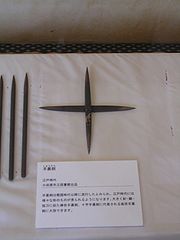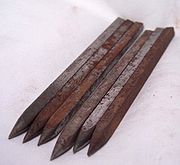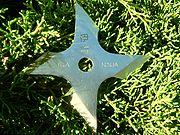
Shuriken
Encyclopedia

Japan
Japan is an island nation in East Asia. Located in the Pacific Ocean, it lies to the east of the Sea of Japan, China, North Korea, South Korea and Russia, stretching from the Sea of Okhotsk in the north to the East China Sea and Taiwan in the south...
ese concealed weapon that was generally used for throwing, and sometimes stabbing or slashing. They are sharpened hand-held blades made from a variety of everyday items such as needles, nails, and knives, as well as coins, washers, and other flat plates of metal.
Shuriken are commonly known in the West as "throwing stars", "ninja
Ninja
A or was a covert agent or mercenary of feudal Japan specializing in unorthodox arts of war. The functions of the ninja included espionage, sabotage, infiltration, and assassination, as well as open combat in certain situations...
stars" or inaccurately as "Chinese stars", though they took many different shapes and designs during the time they were used. The major varieties of shuriken are the bō shuriken (棒手裏剣, stick shuriken) and the hira shuriken (平手裏剣, flat shuriken) or shaken (車剣, also read as kurumaken, wheel shuriken).
Shuriken were mainly a supplemental weapon to the more commonly used sword or other various weapons in a samurai warrior's arsenal, though they often played a pivotal tactical role in battle. The art of wielding the shuriken is known as shurikenjutsu
Shurikenjutsu
is a general term describing the traditional Japanese martial arts of throwing shuriken, which are small, hand-held weapons used primarily by the shinobi in feudal Japan, such as metal spikes bō shuriken, circular plates of metal known as hira shuriken, and knives .Shurikenjutsu was usually taught...
, and was mainly taught as a minor part of the martial arts curriculum of many famous schools, such as Yagyū Shinkage-ryū
Yagyu Shinkage-ryu
is one of the oldest Japanese schools of swordsmanship . Its primary founder was Kamiizumi Nobutsuna, who called the school Shinkage-ryū. In 1565, Nobutsuna bequeathed the school to his greatest student, Yagyū Munetoshi, who added his own name to the school. Today, the Yagyū Shinkage-ryū remains...
, Tenshin Shōden Katori Shintō-ryū
Tenshin Shoden Katori Shinto-ryu
is one of the oldest extant Japanese martial arts, and an exemplar of koryū bujutsu. The Tenshin Shōden Katori Shintō-ryū was founded by Iizasa Ienao, born 1387 in Iizasa village , who was living near Katori Shrine at the time...
, Ittō-ryū
Itto-ryu
, meaning "one-sword school", is the ancestor school of several Japanese Koryū kenjutsu styles, including Ono-ha, Mizoguchi-ha, Nakanishi-ha, Kogen, Hokushin, and Itto Shoden. The style was developed by Ittōsai Kagehisa.-Ono-ha Ittō-ryū:...
, Kukishin-ryū and Togakure-ryū
Togakure-ryū
is a historical tradition of Ninjutsu known as the "School of the Hidden Door", founded during the Oho period by Daisuke Nishina , who learned his original fighting techniques from a Chinese monk named Kain Dōshi. However, the history and early lineage of Togakure-ryū may be impossible to verify...
.
Bo shuriken

The bo-shuriken is thrown in a number of ways, such as overhead, underarm, sideways and rearwards, but in each case, the throw involved the blade sliding out of the hand through the fingers in a smooth, controlled flight. This is not to be confused with the kunai
Kunai
A is a Japanese tool possibly derived from the masonry trowel. Two variations are the and the . It is a good example of a very basic tool which, in the hands of a martial arts expert, could be used as a multi-functional weapon...
, which is a thrusting and stabbing implement that is sometimes thrown.
The major forms of throw are the jiki da-ho (direct hit method), and the han-ten da-ho (turning hit method). These two forms are technically different, in that the former does not allow the blade to spin before it hits the target, while the latter requires that the blade spin before it hits the target.
Bo-shuriken were constructed from a wide variety of everyday items, and thus there are many shapes and sizes. Some derive their name from the materials they were fashioned from, such as kugi-gata (nail form), hari-gata (needle form) and tantō
Tanto
A is one of the traditional Japanese swords that were worn by the samurai class of feudal Japan. The tantō dates to the Heian period, when it was mainly used as a weapon but evolved in design over the years to become more ornate...
-gata (knife form); others are named after the object to which they appear similar, such as hoko-gata (spear form), matsuba-gata (pine-needle form) while others were simply named after the object that was thrown, such as kankyuto (piercing tool form), kunai-gata (utility tool form), or teppan (plate metal) and biao (pin).
Other items were also thrown as in the fashion of bo-shuriken, such as kogai (ornamental hairpin), kogata (utility knife) and hashi (chopsticks), although these items were not associated with any particular school of shurikenjutsu, rather they were more likely just thrown at opportune moments by a skilled practitioner who was skilled in a particular method or school.
The origins of the bo-shuriken in Japan are still unclear despite continuing research in this area. This is partly because shurikenjutsu is a secretive art, and also to the fact that throughout early Japanese history there were actually many independent innovators of the skill of throwing long, thin objects. The earliest known mention of a school teaching shurikenjutsu is Ganritsu Ryu, prevalent during the 17th century. This school utilized a long thin implement with a bulbous head, thought to be derived from the arrow. Existing examples of blades used by this school appear to exhibit a mixture of an arrow's shape with that of a needle traditionally used in Japanese leatherwork and armor manufacture.
There are also earlier mentions in written records, such as the Osaka Gunki (大阪軍記, the military records of Osaka
Osaka
is a city in the Kansai region of Japan's main island of Honshu, a designated city under the Local Autonomy Law, the capital city of Osaka Prefecture and also the biggest part of Keihanshin area, which is represented by three major cities of Japan, Kyoto, Osaka and Kobe...
), of the standard knife and short sword being thrown in battle, and Miyamoto Musashi
Miyamoto Musashi
, also known as Shinmen Takezō, Miyamoto Bennosuke or, by his Buddhist name, Niten Dōraku, was a Japanese swordsman and rōnin. Musashi, as he was often simply known, became renowned through stories of his excellent swordsmanship in numerous duels, even from a very young age...
is said to have won a duel by throwing his short sword at his opponent, killing him.
Hira shuriken

They often have a hole in the center and possess a fairly thin blade sharpened only at the tip. The holes derive from their source in items that had holes – old coins, washers, and nail-removing tools. This proved convenient for the shuriken user, as well, as the weapons could be strung on a string or dowel in the belt for transport, and the hole also had aerodynamic and weighting effects that aided the flight of the blade after it was thrown.
There is a wide variety of forms of hira-shuriken and they are now usually identified by the number of points the blades possess. As with bo-shuriken, the various shapes of hira-shuriken were usually representative of a particular school (ryū
Ryu (school)
A Ryū , or ryūha , is a Japanese word referring to a school of thought in any discipline...
) or region that preferred the use of such shapes, and it is therefore possible to identify the school by the type of blade used.
Usage
Contrary to popular belief, shuriken were not primarily intended as a killing weapon, but rather as a secondary weapon that sometimes played a role supportive to a main weapon, usually the sword or spear. Shuriken were primarily used to cause either nuisance or distraction. Targets were primarily the eyes, face, hands, or the feet, the areas most exposed under armor. The shuriken would sometimes be thrown in a way that cuts the opponent and become lost, later causing the opponent to believe that they were cut by an invisible swordsman.Shuriken, especially hira-shuriken, were also used in other novel ways—they might be embedded in the ground, injuring those who stepped on them (similar to a caltrop
Caltrop
A caltrop is an antipersonnel weapon made up of two or more sharp nails or spines arranged in such a manner that one of them always points upward from a stable base...
or tetsubishi
Makibishi
The term makibishi refers to the Japanese version of the caltrop.-Description:Makibishi , sharp spiked objects that were used in feudal Japan to slow down pursuers and also were used in the defense of samurai fortifications.Makibashi were one of the items supposedly used by ninja...
), wrapped in fuse to be lit and thrown to cause fire, or wrapped in a cloth soaked in poison and lit to cover an area with a cloud of poisonous smoke. They can also be used as a handheld striking weapon in close combat.
There are reports of shuriken being coated with poison intended either for a throwing target or for whoever may pick them up when left in a conspicuous place. Other reports indicate that shuriken may have been buried in dirt or animal feces and allowed to harbor the bacterium Clostridium tetani
Clostridium tetani
Clostridium tetani is a rod-shaped, anaerobic bacterium of the genus Clostridium. Like other Clostridium species, it is Gram-positive, and its appearance on a gram stain resembles tennis rackets or drumsticks. C. tetani is found as spores in soil or in the gastrointestinal tract of animals. C...
—if the point penetrated a victim deeply enough, the bacteria transferred into the wound could cause a then-incurable tetanus
Tetanus
Tetanus is a medical condition characterized by a prolonged contraction of skeletal muscle fibers. The primary symptoms are caused by tetanospasmin, a neurotoxin produced by the Gram-positive, rod-shaped, obligate anaerobic bacterium Clostridium tetani...
infection.
Shuriken are a simple weapon, but their historical value, thanks to their wide variety of uses and the ready availability of material from which they could be made, has increased. Unlike the treasured katana and other bladed weapons, antique shuriken are not often well preserved, largely due to their original status as expendable weapons.
Today
Modern shuriken, unlike historical ones, are most often made of stainless steel and are commercially available in many knife shops in Europe and North America or online. They are however illegal to possess or carry in some countries (e.g. Canada, Germany) while in some countries such as the United States, some regions prohibit them (e.g., California, Indiana), while others allow them. In some cases they may also be allowed, but still subject to specific local legislation. Owners may be required to possess a certificate for the possession of knives.In popular culture
Popularly believed to have been used by Japanese ninja, shuriken are most common in the popular culture in the form of metallic four-pointed hira shuriken. A fictional enlarged version of shuriken is called fūma shuriken.The shuriken can be seen in a wide range of modern media set in historical, modern and even futuristic settings. While shuriken are almost always associated with ninja and to a lesser extent other thieves and assassins, they are sometimes seen as wholly separate from that context.
Literature
- Fujita, Seiko (1928) Zukai Shurikenjutsu (An Overview of Shuriken-jutsu)
- Nawa, Yumio (1962) Kakushi Buki Soran (An Overview of Hidden Weapons)
- Finn, Michael (1983) Art of Shuriken Jutsu
- Hammond, Billy (1985) Shuriken jutsu: The Japanese Art of Projectile Throwing A.E.L.S
- Shirakami, Eizo (1985) Shurikendo: My Study of the Way of Shuriken
- Iwai, Kohaku (1999) Hibuki no Subete ga Wakaru Hon (Hidden Weapons) BAB, Japan
- Kono, Yoshinori (1996) Toru Shirai: Founder of Tenshin Shirai Ryu in Aikido Journal #108
- Saito, Satoshi in Skoss, Diane ed. (1999) Sword & Spirit: Classical Warrior Traditions of Japan Vol. 2 Koryu Books

